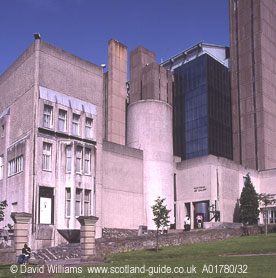(1971-81,
William Whitfield)
The university has a very impressive art collection, part of which is
on display here. A number of the paintings came from William
Hunter`s bequest and since then the collection has grown to become
one of country`s most important. Hunter`s other collections form the basis
of the university`s Hunterian
Museum.
The gallery is housed in this low building which has a copious amount of light coming in through the specially-designed roof. To the left of the main entrance is the exterior of the Mackintosh House and outside the gallery`s entrance stands the bronze sculpture Diagram of an object (1990, Dhruva Mistry) which is a modern representation of a seated mother and child.
Various schools are represented in the gallery and they are generally arranged in chronological order and divided by large screens.
The sixteenth
to nineteenth centuries are divided into four main categories: sixteenth-
and seventeenth-century painting; British and French Painting 1700-1840;
French and Scots Painting 1850-1900.
The gallery`s most famous group of paintings is the Whistler Collection,
dedicated to the work of James Abbot McNeill Whistler (1834-1903).
The achievements of twentieth-century Scottish artists starts with paintings by `The Glasgow Boys`, which includes works by John Quinton Pringle (1864-1925) and Edward A. Hornel (1864-1933). A little further into the twentieth century is the group of artists called the Scottish Colourists, including Stanley Cursiter (1887-1976) and John Duncan Fergusson (1874-1971).
The gallery`s
collection of modern art is divided into two periods. In Scottish
Art 1940-1980 the development from the colourists can clearly be seen
and includes images by John Maxwell (1905-62) and by the celebrated Alan
Davie (1920 -). The most recent works, in the Contemporary Art section,
continue this progression, with various media being on display. Some of
the items are quite abstract.
The print gallery is reached via a spiral staircase opposite the
information desk. The university has a collection of around 20,000 prints
and a number are always on show. The collection covers a wide spectrum
of Western artists, with works by Albrecht Dürer and Pablo Picasso.
The displays are particularly interesting because, as well as showing
prints, there are exhibits with explanations of how the various types
of print are made.
This article is based on the guidebook "The Glasgow Guide".

The entrance to the Hunterian Art Gallery is to the right of the drum tower which is in the centre of the picture. To the left of the drum tower is the Mackintosh House. The University Library is on the right, soaring above the gallery.
The outdoor sculpture courtyard contains exhibits in a variety
of materials, with a number of them constructed in iron, possibly reflecting
the previous importance of the city`s heavy engineering industry. The
sculptures are almost all modern, but pride of place goes to the (relatively
old) Lantern and finial (1899-1900, Charles Rennie Mackintosh). This originally
sat on top of a dome crowning Pettigrew and Stephen`s large department
store in Sauchiehall Street and it was rescued on its demolition in 1973.
Now it can be seen clearly without undue craning of the neck.